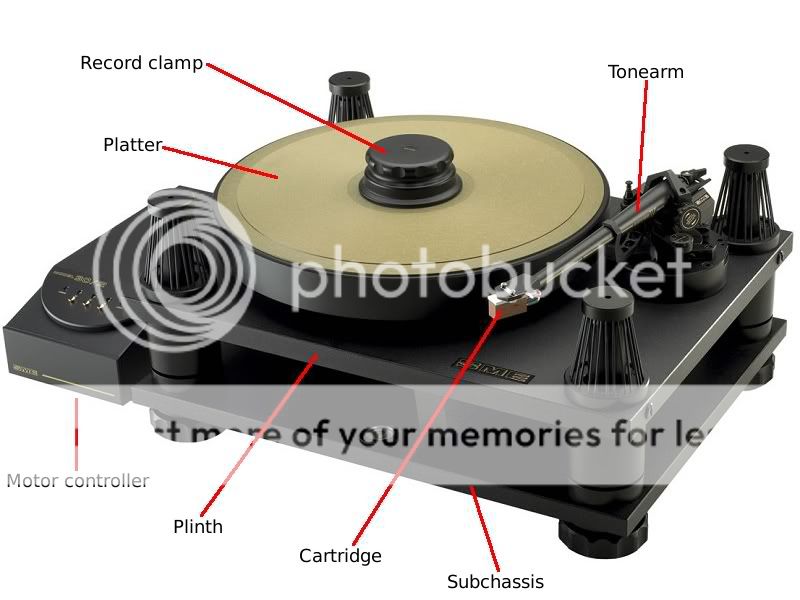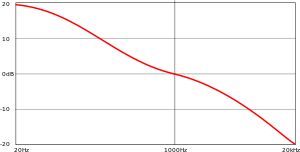More and more people are getting into (or thinking about getting into) playing vinyl records, and some of the terminology us vinyl addicts use can be a bit confusing, especially for new comers. So I thought it would be useful if I put together a glossary of some of the terms we might come across when playing vinyl. I'll improve it over time (especially by adding pictures).
Anti-skate: When using a pivoted arm (or when using a poorly set up parallel tracker), the stylus is only exactly tangential to the groove in two places. The rest of the time, the stylus exerts a small outward force due to its non-tangentiality. To counteract the outward force, pivoted arms have an anti-skate mechanism. Some arms using little weights on tiny cables, but others use more sophisticated methods to apply anti-skating. Anti-skating is also sometimes caller the bias.
Azimuth: How perpendicular to the record's surface the cartrige (or more accurately, its stylus) is. Viewed from the front, the azimuth can be adjusted by rotating the cartridge clockwise or anticlockwise. Note that azimuth adjustment is usually provided by the tonearm, but only a few tonearms actually offer azimuth adjustment. The majority of us have to rely on the tonearm and cartridge being well constructed to very high tolerances.
Cantilever: The finger-like protusion that sticks out the bottom of a cartridge. Cantilevers are made from various materials, with aluminium, boron, and diamond being the most common.
Cartridge: The small box-like thing that holds the cantelever in place, and contains the wires and magnets necessary for record playback. Cartridges typically come in two varieties, moving magnet (MM) and moving coil (MC). MM cartridges are typically cheaper than MC cartridges, and usually have a higher output (roughly 1mV to 7mV). MC cartridges have a lower output (typically 0.1mV to 0.8mV), because they have fewer turns on their internal coils.
Below is a picture of a Koetsu Rosewood Signature Platinum cartridge, showing the stylus and cantilever:
 Cartridge alignment protractor:
Cartridge alignment protractor: This device is an essential part of the turntable owner's toolkit. It has markings on it that enable one to correctly set the cartridge's offset and overhang (i.e., align it correctly) once it has been fitted to the tonearm. They can't be used, however, to set the cartridge's azimuth.
Counterweight: A weight towards the back of a tonearm (behind the bearing) whose job is to counterbalance the cartridge. On many tonearms, the counterweight is also used to set the VTF: move the counterweight further back for less VTF, and nearer the bearing for more VTF.
MC: Moving Coil cartridge.
MM: Moving Magnet cartridge.
Offset: When view from above, this is the angle subtended between the cartridge's axis and the tonearm. This can adjusted in some tonearms by rotating the cartridge clockwise or anticlockwise. This, together with the overhang, is an example of when a picture is worth a thousand words. I'll try to dig up a good one.
Overhang: The distance from the platter's centre (i.e., the spindle) to the tip of the stylus when cartridge is placed over the spindle.
Phono stage: The signals coming from a cartridge (especially an MC cartridge) are very small compared to the usual ~2V from line sources like CD players. Because of this they need a big boost in gain; this gain is provided by the phono stage. To help facilitate cutting, the signal used to cut a record has its bass boosted and the treble rolled off. On playback, a reverese process--called RIAA equalisation--must be performed. It is the phono stage that does this.
Platter: The circular platform upon which the record is placed. Platters are usually made from acrylic, glass, metal, wood, or some combination thereof. Some platters are designed to be used with felt mats, whereas others are intended to be used without a mat.
Plinth: The plinth is a horizontal platform to which are attached the bearing, arm, and sometimes motor. Most turntables have a plinth, but some are plinthless.
Record clamp: A device used to press the record more firmly against the platter than gravity on its own would do. As well as providing a better record to platter interface, record clamps can also help flatten any minor warps or bowing of the record. As an alternative to record clamps, some turntables offer a vacuum suction platter.
Stylus: Strictly speaking, the stylus is the tiny bit of diamond at the end of the cantilever that actually wiggles around in the record's groove. More losely, the term stylus is sometimes applied to the stylus/cantelever assembly, most typically with MM cartridges which have user-replaceable styli.
Tonearm: The stick-like thing that holds the cartridge. There are two different types of tonearm: pivoted and parallel trackers. Pivoted arms are by far the most common.
Below is a picture of an SME Series V, a high end pivoted tonearm:
 Turntable:
Turntable: Strictly speaking, a turntable is the thing that supports the platter and arm, and rotates the platter at the correct speed (the platter is part of the turntable). An integrated turntable consists of a turntable and tone arm that are supplied as a package (in this instance, the turntable is usually not available without an arm). Integrated turntables are often packaged with a cartridge too, to offer beginners an all-in-one solution.
Below is a picture of the SME Model 30/2, a high end integrated turntable (it is also available without an arm):
 VTA:
VTA: An abbreviation of vertical tracking angle, which is the tracking angle of the stylus relative to the record's surface. Depending on the stylus profile, getting the VTA just right can make quite a difference in sound quality. VTA is usually adjusted by raising or lowering the tonearm, or by using spacers between the tonearm and plinth if the former has no VTA adjustment.
VTF: An abbreviation for vertical tracking force. It is the force (or weight) at which the cartridge is tracked at. Typical values range from 1.8g to 2.2g, but one should always follow the manufacturer's recommendations in the manual. Contrary to popular belief, cartridges should
not be tracked at the lightest possible force. Doing so tends to cause poor tracking, which can (in really bad circumstances) lead to the groove being damaged.
If anyone has suggestions for improving this (including any other terms that would be helpful), I'm happy to hear them!
With permission, the following information is added by Big Daddy.
Line-Level Inputs, Phono Inputs, and RIAA Equalization
Line-level signals are low-level signals, usually routed and/or switched between audio components, before final amplification. When you are connecting a CD/DVD/BD player to your receiver, you are dealing with line-level inputs.
Line-level signals do not follow the volume control. The user chooses and mixes the line-level signals. The receiver/amplifier then amplifies them, which involves the volume control. In the case of very low level signals, like phonograph cartridges, a "preamp" is used through the dedicated phono input to increase the weak signal to line level. If the receiver/prepro does not have a phono input or built-in phono preamp, an external unit is needed.
http://www.epanorama.net/circuits/phono.html
Quote:
Many amplifiers have phono inputs for connecting record players to the amplifier. Phono input is designed to take up to few millivolt signal from phono pickup and amplify it. The amplifier stage does also some equalization based on standardized RIAA curve. The RIAA reproduction curve:
That RIAA equalization is used in the playback to reduce the high pitch noise and maximize bass dynamics in the phono playback. The audio material which is rocorded to the record has been pre-equalized so that the frequency response of the whole chain from the mixing desk to your speaker will give flat frequency response.
General information on phono input
When choosing a cartridge for a given phono section, it is the "gain" or output that have to match.- Typically almost all receivers, and most integrated amps have standard 'low-gain' phono preamplifying sections (30dB to 38dB of gain typically). These require the use of either moving magnet cartridges (typically in the 2.0 to 5.0mv range) or high output moving coil types (generally 1.5 to 2.0mV output).
- The better preamplifiers (and the odd integrated or receiver) accept low-output moving coil cartridges - which have outputs of .2 to .9mV. These high gain phono sections will typically have approx 55dB to 75dB of gain.
- Very old tube amplifiers (50 years old) have had CERAMIC cartridge input which is very high input and accepts around 100mV signal level.
Different cartridge types:- MM (Moving Magnet) cartridges are designed to play into 47k ohms or higher input impedance. MM's will typically be loaded with capacitive loading in the pF range. Moving magnet phono cartridges have a typical output of ~3mv at 47K Ohm load. Moving magnet cartriges are the ones most commonly used.
- MC (Moving Coil) cartridges are typically designed to be loaded anywhere from 10 ohms to 1000 ohms.
- Ceramic catridges are high impedance signal sources. Their are not used nowadays because they were not "hifi quality".
|
http://www.enhancedaudio.com/eqcurve.htm
Quote:
In order to create records in the first place, adjustments had to be made to compensate for the lack of surface space on a record. Because records rely on grooves, in order to accurately relay Bass passages on a record, the grooves would need to be so far apart that in many cases it would be impossible to fit a full song on a 78 or more than one or two on an LP. In order to compensate, records were designed minus a great deal of the Bass and manufacturers depended on the equipment that they were played on to add that bass back into the file during the listening process.
An EQ Curve is simply a preset equalizer that says, "I know you're going to be missing these frequencies...I'll just put them back in automatically."
The RIAA curve was designed for LPs and 45s. Almost all modern preamps or stereo systems add this RIAA curve in one respect or another on playback. In the heyday of turntables and stereo systems, many folks would shop for hours until they found the stereo system that sounded best. Because all stereos sounded differently, this can let you know just how well this RIAA curve was followed. Each company interpreted these EQ settings with their own style. While this was good for listening, it may not be the best for today's technology. If you are mainly transferring LPs and 45s to the computer, you may want to read about the CTP1000 Flat Phono Preamp Series. Just Click Here.
78 records were designed differently and require a different set of equalizer settings in order to play them accurately.
|
http://en.wikipedia.org/wiki/RIAA_equalization
Quote:
RIAA equalization is a specification for the correct playback of gramophone records, established by the Recording Industry Association of America (RIAA). The purpose of the equalization is to permit greater playback times, improve sound quality, and to limit the vinyl damages that would otherwise arise from recording analog records without such equalization.
The RIAA equalization curve has operated as a de facto global industry standard for the recording and playback of vinyl records since 1954. Before then, especially from 1940, each record company applied its own equalization; there were over 100 combinations of turnover and rolloff frequencies in use, the main ones being Columbia-78, Decca-U.S., European (various), Victor-78 (various), Associated, BBC, NAB, Orthacoustic, World, Columbia LP, FFRR-78 and microgroove, and AES.
|































 Hybrid Mode
Hybrid Mode
